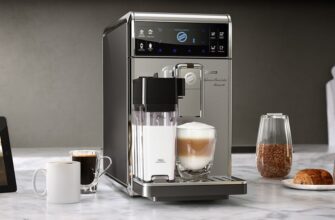In this article, we will consider a more effective way to solve the issue of high-quality and uninterrupted power supply to the house - the use of an uninterrupted power source. Let's analyze the main types of UPS that can be purchased in a store https://elektrokonyk.com.ua/ups-dbzh/, let's define, which are most suitable for the home, and we will also share useful recommendations on choosing the right uninterruptible power supply for the home.
- Purpose of UPS for home
- Types of UPS
- Backup type UPS (off-line)
- Linear-interactive UPS (line-interactive)
- Online UPS (on-line)
- Criteria for choosing a home UPS
- UPS type
- Power
- Operating voltage range and output signal shape
- Time of autonomous operation and transition to battery
- Availability of additional functionality
- Common mistakes and an example of the correct choice of uninterruptible power supply for the home
Purpose of UPS for home
Nowadays, it is difficult to imagine a residential private house without a "traditional" set of simple ones, and high-tech electrical appliances: lighting systems, heating, ventilation, water supply and security, various household appliances, televisions, PK, notebook, vacuum cleaner, washing machine, air conditioner. All modern engineering systems, equipped with electronic components, as well as the complex household appliances of our houses are becoming more perfect every year.
However, significantly simplifying life and saving our time, At the same time, the vast majority of household appliances require compliance with mandatory operating conditions, one of which, certainly, there is a high-quality and uninterrupted power supply. Inconsistency in power supply parameters or sudden power outages, at best, will lead to incorrect operation or reduction of the service life of the equipment, at worst, - before its premature failure. Preventing all these consequences will allow the installation of an uninterrupted power source for the home.
A UPS is simply necessary in those cases, when periodic power outages occur in a house or apartment. Most often, the reasons for this may be the effects of atmospheric phenomena on power lines (rain, hurricane wind, ice on the wires, that cause them to break) or improper condition of electrical networks and auxiliary equipment, resulting in emergency shutdowns.
Choosing UPS for home, you should know, that the device solves two tasks at once.
| UPS functionality | Comment |
| Provision of uninterrupted power supply | UPS, working offline, provides uninterrupted power supply to devices, reserved in the batteries. |
|---|---|
| Voltage stabilization | If there is a built-in voltage stabilizer, the UPS can correct voltage parameters to nominal values. |
Types of UPS
Of course, there cannot be a universal UPS for the home. The appropriate type of device is largely determined by the type of load, which requires uninterruptible power supply, the nature of possible problems and interruptions in the power supply network.
For home use, in some cases, the cheapest UPS of backup and linear-interactive types on the market are suitable. However, there is another more expensive one, but also a more universal and perfect type of jammers, which works on the principle of double conversion. It is able to provide the highest quality and reliable protection of any home appliances. Next, we will consider each of these types in more detail.
Backup type UPS (off-line)
Such devices are quite suitable for work with undemanding power loads. They differ in the absence of a voltage stabilization unit and, usually, designed to work with a load of low power consumption.
In the event of interruptions in the main network or unacceptable voltage deviations from the norm, the backup type UPS simply switches to autonomous mode, switching the load to battery power. When the power supply is restored, consumers are redirected to the main network.
The great advantage of using uninterruptible power supplies of this type is the simplicity of the device, sufficient operational reliability and low cost.
Obvious disadvantages of backup type UPS – this is the switching time when going offline and back (In average 4-10 ms) and no stabilization function. In total, with a change in the sinusoid of the output voltage, characteristic of most UPS of this type, we can say, that their use will be acceptable only for undemanding to the shape of the signal and voltage dips of the load.
Linear-interactive UPS (line-interactive)
For more demanding voltage quality and uninterrupted power supply of household appliances, we can recommend UPS of linear-interactive topology (line-interactive). Their main difference from the reserve type is the presence of a voltage control and stabilization function.
Voltage correction, performed by an autotransformer, ensures normal operation of household appliances with reduced or increased network voltage without switching to battery operation.
UPS of this type is distinguished by the possibility of supplying voltage with a cleaner sinusoid, well suited for work with power-sensitive electrical appliances (example, PK, printers, TV and video equipment) and machinery with electric motors (example, circulation pumps of heating and water supply systems).
Disadvantages of the UPS include the non-instant transition to battery operation, the degree of regulation of the output voltage and the rather high cost of the devices today.
Online UPS (on-line)
A feature of their work can be called the constant process of double conversion of alternating voltage. The main advantage of such UPS, certainly, there is no time to go into offline mode, provided by technology, that is used online.
These sources of uninterruptible power supply for a private house have a higher cost compared to other types of UPS due to their manufacturability. However, their household use will be fully justified to protect particularly important and most demanding electrical appliances in networks with extremely low quality electricity and frequent interruptions in power supply.
The output waveform of the UPS is a perfect sine wave, which is guaranteed to work with any electric motors. The presence of a through neutral makes these uninterruptible power supplies indispensable for working with phase-dependent electronic control units of heating boilers.
Criteria for choosing a home UPS
Experts in the field of power supply agree, what, choosing a UPS model, it is necessary to be guided by such criteria:
- device type;
- power;
- range of operating voltages;
- duration of work in offline mode;
- sometimes switching to battery operation and vice versa;
- form of the output signal.
Consider them in more detail.
UPS type
The correct choice of type of uninterruptible power supply depends on the nature of the load, that connects, network voltage stability, frequency and possible duration of interruptions in the supply of electricity. The table below compares the main types of UPS and their application situations.
| UPS type | Scope of application |
| Reserve | In the absence of significant voltage fluctuations and rare power outages. In such conditions, the device will last quite a long time and will be able to ensure normal operation, for example a PC, monitor or router. |
|---|---|
| Linear interactive | With frequent fluctuations in voltage with its value exceeding the operating ranges. In addition to the presence of a voltage stabilization function, these devices are distinguished by a shorter switching time to work from the battery. However, choosing UPS for the boiler room of a private house, the characteristics of the output signal shape should be carefully studied. Different UPS models can give a clean output, and a modified sinusoid, which is important for the normal operation of electric motors of pumps. |
| online | The use of a double-conversion UPS for home use will be justified, if it is necessary to ensure reliable power supply of extremely voltage-sensitive electronic equipment of engineering systems (heating, water supply, ventilation or protection) due to low quality and frequent power outages, which often differ between rural and summer cottage networks. |
Power
The power of the UPS should not be less than the total consumed power of the load, that connects. Underpowered device may cause malfunctions. An excessive capacity reserve is also undesirable, because it leads to unjustified financial costs and low operational efficiency. The reserve recommended by many manufacturers is 25-30% from the power consumption of all electrical appliances, that connect.
Operating voltage range and output signal shape
The required width of the range depends on the individual parameters of the network and the magnitude of its possible fluctuations in both directions. Example, online UPS have an extended input voltage range, which allows you to stabilize the voltage even with strong network drops and at the same time not to transfer the power of the load to the battery.
For the efficient operation of electrosensitive devices, the output voltage of the UPS must be a perfect sine wave.
Time of autonomous operation and transition to battery
It is important to understand here, how long the load will work from the battery, and, is it possible to increase the battery capacity by connecting additional batteries, if it is intended to use the home UPS autonomously for a long time.
in addition, for some electrical appliances, the lack of time to switch to battery operation when the electricity in the network is turned off is extremely important.
Availability of additional functionality
When choosing a UPS, in addition to the exact selection of the type of device and its technical characteristics, it is very important to pay attention to the availability of useful functionality, which will help organize more efficient work with different types of load, in particular:
| function | Description |
| "Cold" start | The presence of this function allows you to turn on electrical appliances from the battery of the power source in the absence of external network voltage. |
|---|---|
| “hot” battery replacement | The possibility of replacing batteries without turning off the UPS. |
| Automatic shutdown of the load | Option, which allows you to automatically and correctly terminate the operation of the PC when the battery is critically discharged. |
| Parallel operation of UPS | Support for synchronizing the operation of several UPSs is relevant if it is necessary to create a single power backup network, connecting multiple devices. |
| Connecting external batteries | An important option if it is necessary to increase the duration of the autonomous mode of operation. |
| Monitoring | Possibility of remote/local monitoring and management of the UPS (the presence of the necessary connectors, communication ports and support for relevant data transfer protocols). |
Common mistakes and an example of the correct choice of uninterruptible power supply for the home
Disregarding the above criteria, users make mistakes when choosing uninterruptible power supplies, example:
- incorrect power selection of the device (without taking into account the high starting currents of the reactive load);
- incorrect selection of UPS type: the use of devices without voltage stabilization when operating in networks with large values of voltage drops or devices with a modified sinusoid for powering electric motors;
- incorrect calculation of the required battery capacity, which does not correspond to the power of the load and the required duration of operation in autonomous mode
As an example of the correct selection, we offer to consider the choice of a UPS for powering the heating system, consisting of three circulation pumps and an electronic boiler control unit. This field of application is quite common: UPS is often used in private residential buildings, for whom a power outage in winter is highly undesirable.
| UPS selection stage | Description |
| We determine the power of the UPS | Pumps with a capacity of up to 100 W, and the consumption of electronics of modern heating devices lies in the range 100-200 W. So, the total power of the three pumps is the power 45 W will be 135 W. In view of their high starting currents, we will double this result and obtain 270 W. By adding to it the value of the boiler's power consumption (it can be found out from passport data), we will get the necessary value of UPS power - no more 500 W. |
|---|---|
| Select the UPS type | UPS type, what is recommended, – online, double transformation, which is guaranteed to be able to provide high-quality power supply to the boiler and pumps, including phase-dependent ones. A more budget-friendly alternative can be the choice of a linear-interactive type device, however, selecting this type, you need to be sure of the shape of the output signal - it must be a pure sine wave. |
| We determine the battery capacity | The required battery capacity of the selected uninterruptible power supply will depend on the long-term autonomous operation. To increase it, it is advisable to consider models when choosing, that support the installation of additional external batteries. This will make it possible to scale the time of operation of the heating system in the absence of voltage in the network. |












